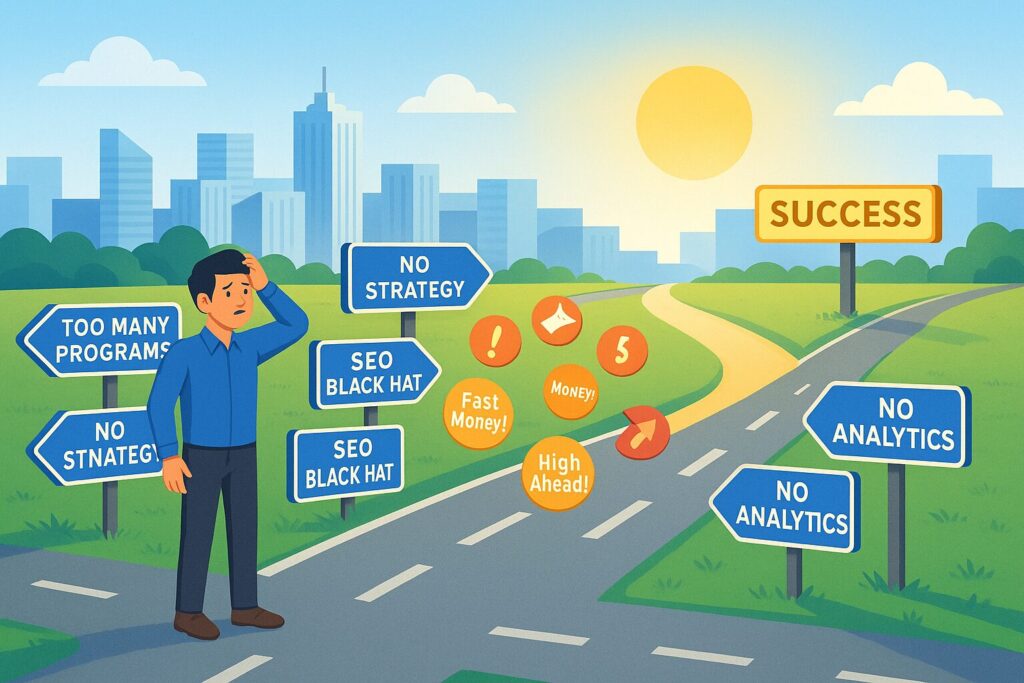Automated Affiliate Funnels: Earn While You Sleep Without Being Salesy
Affiliate marketing is one of the most powerful ways to build online income — but most bloggers get it wrong. They sprinkle a few affiliate links into blog posts, cross their fingers, and hope for clicks.
And then they wonder why their commissions barely cover a cup of coffee.
The real money in affiliate marketing comes when you stop treating it like an afterthought and start treating it like a system.
That’s where automated affiliate funnels come in.
An affiliate funnel works 24/7 to turn casual readers into buyers. It educates, nurtures trust, answers objections, and gently leads to the sale — all without you needing to be “salesy” or chase people around the internet.
Let’s build yours step by step.

Why You Need an Affiliate Funnel
Think of a funnel as a guided journey. Most visitors to your blog aren’t ready to buy on the first visit. They’re looking for information, researching options, and comparing products.
Without a funnel, they read your post, maybe click a link, and disappear forever.
With a funnel, you:
- Capture their email address so you can stay in touch.
- Deliver valuable content over time — building trust and positioning yourself as an authority.
- Show them solutions to their problem and recommend the product that solves it.
- Convert far more readers into happy buyers — automatically.
This is the difference between hoping someone buys and engineering a process that leads to sales every single day.
Step 1: Choose the Right Affiliate Offer 🎯
Before you even think about email sequences, start with the right offer. The product you promote has to:
- Solve a clear, painful problem.
- Be something you genuinely believe in (your reputation is on the line).
- Offer a decent commission structure — ideally recurring.
Example: If your audience is new bloggers, you might promote website hosting, email software, or keyword research tools. These are products they truly need, and they’re likely to stick with them for months (or years).
The “Problem-Solution” Filter
Ask yourself:
- What problem does this product solve?
- Can I tell a story about how it helped me or someone I know?
- Is the solution urgent or important enough for someone to spend money on?
If you can confidently answer yes, you’ve found a good funnel product.
Step 2: Create the Perfect Entry Point
An affiliate funnel starts with a lead magnet — something valuable enough that your readers are willing to exchange their email address for it.
Examples:
- Checklists: “7 Tools Every Blogger Needs to Run Their Business”
- Mini-Courses: “5-Day Challenge: Build Your First Email Funnel”
- PDF Guides: “Affiliate Marketing Starter Kit”
- Webinars: Teach a live or recorded session about solving a specific pain point.
The best lead magnets are simple, actionable, and directly related to the affiliate product you’ll recommend later.
Pro Tip: Make your lead magnet a shortcut to solving a problem. People love quick wins.
Step 3: Build a Nurture Sequence
Once they opt in, you need to guide them step by step. A nurture sequence is a series of emails that:
- Welcome your subscriber and deliver the lead magnet.
- Provide value with tips, stories, and education.
- Show the solution — talk about how the affiliate product fits into solving their problem.
- Handle objections — cost, difficulty, “do I really need this?”
- Present a call-to-action — invite them to check out the product, ideally with a bonus incentive (your free template, guide, or extra resource).
Funnel Psychology: Why This Works
People rarely buy on the first touch. Marketing studies show it takes 5–7 touchpoints before someone is ready to make a purchase decision.
Your funnel gives them those touchpoints automatically — without you having to manually follow up.
Step 4: Automate the Delivery
This is where it gets fun. Once your funnel is set up, your work is mostly done.
Use an email marketing platform like:
- ConvertKit: Easy to use, perfect for creators.
- MailerLite: Affordable and beginner-friendly.
- ActiveCampaign: Great for advanced automation and tagging.
Set up your automation to:
- Deliver your lead magnet instantly.
- Drip out your nurture sequence over a few days.
- Tag subscribers based on their actions (clicks, opens, etc.).
Now, whether you’re working, sleeping, or on vacation, new subscribers go through your funnel automatically.

Step 5: Drive Traffic to the Funnel
Even the best funnel won’t work without traffic. Focus on long-term, evergreen sources:
- SEO Blog Posts: Write keyword-targeted posts that answer specific questions.
- Pinterest Pins: Design pins that lead directly to your opt-in page.
- YouTube Videos: Show quick tips and link to your freebie in the description.
- Guest Posts & Collaborations: Borrow audiences from other creators.
Think of traffic as fuel — the more targeted visitors you send in, the more sales your funnel produces.
Step 6: Optimize for Conversions
Once your funnel is live, tweak and improve it over time:
- Test subject lines to boost open rates.
- Add more storytelling to build emotional connection.
- Experiment with the timing between emails.
- Include a P.S. in each email with a clickable link for skimmers.
Even small changes can double your results.
Step 7: Track Your Metrics
A good marketer measures what matters. Track:
- Opt-in Rate: How many visitors subscribe?
- Open Rate: Are your subject lines compelling enough?
- Click-Through Rate: Are readers engaging with your links?
- Conversion Rate: How many purchases result from your funnel?
These numbers tell you where to focus your improvements.
Step 8: Rinse, Repeat, and Scale
Once your first funnel is converting, don’t stop.
- Clone it for other products.
- Create a “hub” page with all your best freebies.
- Build cross-promotions (one funnel leads to another).
This is how you build multiple streams of automated income over time.
E-E-A-T: The Secret to Trust and Rankings
Funnels only work if people trust you. Google’s quality guidelines focus on E-E-A-T:
- Experience: Share your personal journey with the product.
- Expertise: Demonstrate why you’re qualified to recommend it.
- Authoritativeness: Link to credible sources, show social proof, and build reputation.
- Trustworthiness: Disclose affiliate relationships and be honest about pros/cons.
When readers feel you’re genuinely helping them — not just selling to them — conversions go up dramatically.
Common Mistakes to Avoid
- Promoting too many products: Stick to a few core offers.
- Hard selling too soon: Focus on education first.
- Never updating your funnel: Refresh copy and offers every few months.
- Ignoring data: Metrics tell you what’s working — don’t fly blind.
Tech Stack Cheat Sheet 🖥️
| Tool | Best For | Key Strengths |
|---|---|---|
| ConvertKit | Creators, bloggers | Clean automations, visual builder |
| MailerLite | Budget-conscious beginners | Simple UI, free plan up to 1,000 subs |
| ActiveCampaign | Advanced marketers | Deep segmentation, robust analytics |
Pick the one that matches your level and budget — don’t overcomplicate it.
Product Spotlight
HP Pavilion 15 Laptop 💻
A reliable laptop is a must for managing email automation, creating content, and running analytics smoothly. The HP Pavilion 15 delivers power and portability at a price point that makes sense for new entrepreneurs.
Call to Action: Learn Affiliate Funnels Faster
Building your first funnel can feel intimidating — but you don’t have to do it alone.
Check out Wealthy Affiliate. You’ll get step-by-step training on:

- Keyword research
- Affiliate site building
- List growth strategies
- Converting traffic into consistent income
This is exactly how I’d shortcut months of trial and error if I were starting today.
FAQs
Q: How many emails should be in my funnel?
Start with 4–6, then add more if you see good engagement.
Q: Do I have to use paid ads?
No. Organic traffic (SEO, Pinterest, YouTube) is more sustainable, though ads can help accelerate results.
Q: How soon can I expect to make money?
It depends on traffic volume, but many people see their first commissions within a few weeks if they send consistent visitors into the funnel.
Q: Can I run multiple funnels at once?
Yes, but start with one to avoid overwhelm. Optimize it first, then scale.
Final Thoughts
An automated affiliate funnel is like having a tireless salesperson who works around the clock — without annoying anyone.
When you create a clear path from problem to solution, nurture trust, and automate the process, you build a system that works for you 24/7.
Start small: pick one affiliate product, create a simple freebie, and write a short email sequence. Once you see that first automated commission hit your account, you’ll be hooked.
That’s when you’ll realize you’ve built more than a funnel — you’ve built freedom. 🌙💸

Larry Mac
Hi there, and thanks for stopping by! My name is Larry, and I’m the voice behind 6fig.com. I search the Internet to try and find money-making opportunities to share.. Thanks for stopping by. Feel free to subscribe and comment. Thank You!
You Got This, I Learned these skills and more at Wealthy Affiliate. Hey, if this 65-year-old Grandfather can make money online, you can too!


